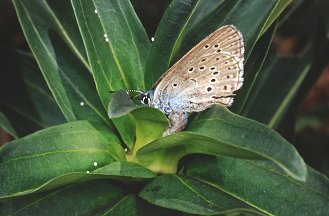Scientists from Oxford and Turin have found that certain species of caterpillars have developed the ability to use sounds to fool ants into accepting and nurturing them.
 Writing in this week's Science Francesca Barbero and her colleagues describe how they used sensitive microphones to eavesdrop on Myrmica schencki ants, the nests of which are invaded by caterpillars of the rare blue butterfly Maculinea rebeli. Somehow these caterpillars persuade the ants not just to accept them but also to treat them like royalty, even feeding their own young to the hungry butterfly larvae if food runs short.
Writing in this week's Science Francesca Barbero and her colleagues describe how they used sensitive microphones to eavesdrop on Myrmica schencki ants, the nests of which are invaded by caterpillars of the rare blue butterfly Maculinea rebeli. Somehow these caterpillars persuade the ants not just to accept them but also to treat them like royalty, even feeding their own young to the hungry butterfly larvae if food runs short.
Scientists have known for some time that chemicals come into play and that the caterpillars secrete odour molecules that make them smell like an ant, but that couldn't be the whole story because it wouldn't explain why the larvae receive such preferential treatment in the nest. This prompted the Oxford and Italian team to wonder whether the caterpillars might also be resorting to a form of sonic subterfuge to elevate their status because the ants communicate with one another through rasping sounds produced by rubbing together the rough surfaces of parts of their abdomens.
Queen ants produce subtly different sounds to workers, and recordings from the caterpillars in the nests show that they are mimicking the noises of ant queens.
| Myrmica schencki - Queen Ant |
| Maculinea rebeli - Caterpillar |
"This is the first time anyone has been able to record like this, with insects in their native environment and that are not distressed. This is why we picked this up," explains co-author Jeremy Thomas. "This is a wonderful example of evolution. This blue butterfly group has a long history of a co-existence with this ant species. Over time the caterpillars have adapted to exploit the ants by mimicking their signals, allowing the caterpillar to penetrate the nest where the ants protect and feed it."










Comments
Add a comment